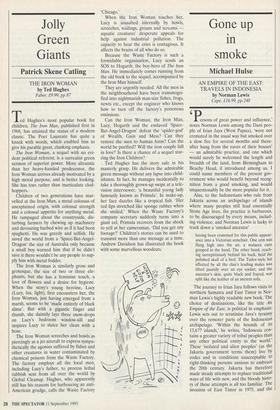Jolly Green Giants
Patrick Skene Catling
THE IRON WOMAN by Ted Hughes Faber, £9.99, pp.87 Td Hughes's most popular book for children, The Iron Man, published first in 1968, has attained the status of a modern classic. The Poet Laureate has quite a knack with words, which enabled him to give his parable great, clanking emphasis.
The Iron Woman, a sequel with no evi- dent political referent, is a surrealist green sermon of superior power. More altruistic than her heavy-handed predecessor, the Iron Woman arrives already motivated by a high moral purpose, and is better looking. She has toes rather than inarticulate clod- hoppers.
Children of two generations have mar- velled at the Iron Man, a metal colossus of unexplained origin, with colossal strength and a colossal appetite for anything metal. He rampaged about the countryside, dis- turbing farmers by chewing up machinery and devouring barbed wire as if it had been spaghetti. He was greedy and selfish. He saved the world from a 'Space-Bat-Angel- Dragon' the size of Australia only because a small boy warned him that if he didn't save it there wouldn't be any people to sup- ply him with metal fodder.
The Iron Woman is similarly gross and grotesque, the size of two or three ele- phants, but she has a feminine touch, a love of flowers and a desire for hygiene. When the story's young heroine, Lucy (Lucy, lux, light), first encounters her, the Iron Woman, just having emerged from a marsh, seems to be 'made entirely of black slime'. But with a gigantic finger and thumb, she daintily lays three snow-drops on Lucy's bedroom window-sill and inspires Lucy to sluice her clean with a hose.
The Iron Woman screeches and howls as piercingly as a jet aircraft to express sympa- thetically the agonies suffered by fishes and other creatures in water contaminated by chemical poisons from the Waste Factory. The factory employs all the local men, including Lucy's father, to process lethal rubbish sent from all over the world by Global Cleanup. Hughes, who apparently still has his reasons for harbouring an anti- American grudge, calls the Waste Factory `Chicago '
When the Iron Woman touches her, Lucy is assaulted internally by howls, screeches, wailings, groans and screams aquatic creatures' desperate appeals for help against industrial pollution. The capacity to hear the cries is contagious. It affects the brains of all who do so.
Because the Waste Factory is such a formidable organisation, Lucy sends an SOS to Hogarth, the boy-hero of The Iron Man. He immediately comes running from the old book to the sequel, accompanied by the Iron Man himself.
They are urgently needed. All the men in the neighbourhood have been transmogri- fied into nightmarish man-size fishes, frogs, newts etc., except the engineer who knows how to turn off the factory's poisonous emissions.
Can the Iron Woman, the Iron Man, Lucy, Hogarth and the enslaved 'Space- Bat-Angel-Dragon' defeat the 'spider-god' of Wealth, Gain and Mess? Can they restore the men to human form? Can the world be purified? Will the iron couple fall in love? Is there a chance of a sequel star- ring the Iron Children?
Ted Hughes has the story safe in his masterly grasp. He delivers the admirable green message without any lapse into child- ishness. In fact, he manages incidentally to take a thoroughly grown-up swipe at a tele- vision interviewer, 'a beautiful young lady famously known as Primula'. In make-up, her face dazzles like a tropical fish. 'Her red lips stretched like sponge rubber when she smiled.' When the Waste Factory's company secretary suddenly turns into a giant eel, Primula recovers from the shock to yell at her cameraman, 'Did you get any footage?' Children's stories can be used to transmit more than one message at a time. Andrew Davidson has illustrated the book with some marvellous woodcuts.


















































 Previous page
Previous page